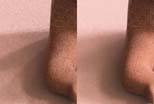|
After reading some posts from other LW users on CGTalk.com, I did a new set of renders. In this set all the same scene files and objects were used. I started with the same Light Probe, Galileo's Tomb, but in each render I applied Full Precision Blur in larger amounts with each render. Image (11) was rendered with RPE 3 x 9 and Full Precision Blur(FPB) of 2 x 2, (12) was rendered with RPE 3 x 9 and FPB of 14 x 14, (13) was rendered with RPE 3 x 9 and FPB of 28 x 28, and (14) was rendered with RPE 6 x 18 and FPB of 28 x 28. All render times were about 30 minutes, but ones with RPE settings over 6 x 9 were much longer, even with 2 2.5 ghz Xeon CPUs and 4 threads(and Hyperthreading enabled for each CPU) The results are below: Some other readers suggested I try using not only blurred versions of the Light Probes, but lower resolution versions. I used HDR Shop to do the conversions. In the next set I sampled the Galileo's Tomb Light Probe down from 1000 x 1000 pixels to 512 x 512 pixels. I was disappointed to see that rendering with the 512 x 512 pixel version of Galileo's Tomb (14) took almost an hour to render 50 minutes vs 35 minutes for the 1000 x 1000 versions (11), (12) above. I then reduced the resolution of the Light Probe to 256 x 256 and the render (15) took even longer–over one hour. These results are completely counter to what was suggested by some of the people posting on CGTalk, yet these results are accurate and repeatable. In (16) the only difference with (15) was that I used HDR Shop to blur the Light Probe by converting it to Horizontal Coordinates, applied a 4 x 4 gaussian blur and converting back to a Light Probe. It may be that a lower resolution version of a Light Probe ends up needing more calculations to sample up to the volume of the scene being illuminated. Maybe not. Below is a side by side comparison of the best of each sets of renders; on the left is the best looking render from the initial round (7) with RPE set to 10 x 30 which took several hours to render. On its right is the best of the second set (13) which took much less time to render. What you gain with the high RPE settings you lose in time, and even settings that high are no guarantee that there won't be any noise. What you gain with a blurred Light Probe is a way to avoid high RPE settings, but the blurred Light Probe will cost you detail in the shadows and lighting in the image. You can see this in the lower left of each image in the side by side comparison below. In the final round of renders, again following suggestions, I tried using a different Light Probe file–this time Grace Cathedral. As with the other examples, I started at 1000 x 1000 pixels and went down with each render. RPE was set to 3 x 9 in each case to cut down on time. In (17) the Light Probe was 1000 x 1000 and given no gaussian blur. It took 54 minutes to render. In (18) the Light Probe was 256 x 256 and given a 4 x 4 gaussian blur. It took 55 minutes to render.The results are below: Conclusions: My conclusions are about the same as before. If the Light Probes used in a render are blurred, the result is similar to what would happen with high RPE settings or high antialiasing or both. At this point these techniques take too much time to set up properly and the results are too variable make into a system that can yield repeatable results. In my view a more practical application for these techniques would be to derive a lighting rig from the information in the Light Probe itself. Maybe an LScript that could create a sphere of lights each of which gets its color and brightness from the information in the Light Probe. Maybe a UI to designate how many lights end up in the rig? Maybe a script like this already exists? If so please email me:
|









